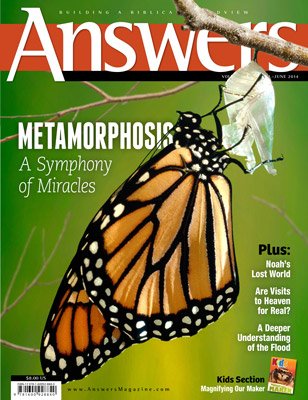Answers Research Journal
Answers Research Journal was started in 2008 to glorify the Creator by evaluating scientific findings in light of Scripture. The goal is to bring together some of the finest minds in creation research to provide the best possible insights into God’s work since Creation Week. ARJ stands apart as a top-quality, free online journal, which can quickly distribute new findings in creation research, including unlimited space for graphics and color images. Below is a taste of the newest insights you can gain from ARJ at AnswersResearchJournal.org.*
Predicting Genetic Differences Between Kinds
Why do anatomically distinct species have similar molecular sequences? Why do physically similar species have major genetic differences?
Evolutionists attribute shared sequences to inheritance from a common ancestor. Conversely, they explain genetic differences as a result of evolutionary changes over time.
Evolution predicts that species will grow more and more distant at the molecular level (including but not limited to their DNA) over time. Because natural selection favors certain animals based on their superior functions, evolutionists assume that the surviving DNA and other molecular sequences must produce these functional benefits.
In contrast, creationists explain shared sequences either by God’s initial creation or by convergence since Creation Week. In either scenario, the creation model also predicts that highly similar sequences exist for a functional purpose. But it lacks a clear, predictive explanation for molecular diversity.
Dr. Nathaniel Jeanson researched molecular differences between biblical kinds and found that they can be explained in functional terms. He also found that we can predict genetic differences within a kind based on modern mutation rates and the young-earth timescale. These findings provide a compelling alternative to evolutionary explanations.
See “Recent, Functionally Diverse Origin for Mitochondrial Genes from ~2700 Metazoan Species” by Nathaniel T. Jeanson.
Avian Ark Kinds
As part of the Answers in Genesis Ark Encounter project, researchers are working to identify and number the “kinds” of animals on the Ark. Dr. Jean Lightner identifies 196 possible bird kinds, and highlights their fantastic diversity.
Newly available genetic data has created significant problems for an evolutionary “family tree.” This new data reveals that an enormous number of common traits in birds are not the result of common ancestry, forcing evolutionists to believe the same trait evolved many separate times. In addition, similar genes don’t necessarily correspond to similar physical traits, as evolution would predict.
In general, creationists estimate that the biblical kind is roughly at the classification level of the family. Sometimes, however, birds from very diverse families can mate and produce offspring, and other data sometimes suggest a higher classification level.
The possibility that, at least in the case of birds, kinds may refer to a higher level of classification leaves creationists with exciting research questions concerning how such a wealth of diversity arose within created kinds after the Flood.
See “An Initial Estimate of Avian Ark Kinds” by Jean Lightner.
Cratering
Danny Faulkner summarizes past creationist discussions of how craters fit into the creation model and further develops his own suggestion—most solar system craters date from the formation of astronomical bodies on Day Four of Creation Week. He points out that cratering, although it involves processes that may be considered catastrophic, need not be associated with judgment and is consistent with the “very good” of Genesis 1:31.
Dr. Faulkner then interprets the appearance of planets, moons, and asteroids in our solar system that have solid surfaces and have been photographed with sufficient resolution. He suggests that the heavily cratered surfaces bear testament to the latter stages of their formation on Day Four, when they were assembled from matter created on Day One. The less cratered and/or less modified surfaces have undergone geologic changes since the Creation Week, and in some cases we still observe volcanic (and cryovolcanic) activity on those bodies.
Dr. Faulkner concludes with suggestions for further research within a young-earth framework.
See “Interpreting Craters in Terms of the Day Four Cratering Hypothesis” by Danny Faulkner.
* The views expressed in the Answers Research Journal (ARJ) are those of the writers and not necessarily those of the editors of the ARJ or of Answers in Genesis.
Answers Magazine
April – June 2014
A closer look at the Genesis Flood account reveals a beautifully written, unified narrative that points to one inspired author. The passage masterfully highlights one central message: “God remembered Noah.” Along with in-depth articles on the Flood, this issue shows biblical and historical evidences of Christ’s Resurrection, new discoveries about the miracle of a butterfly’s metamorphosis and much more!
Browse IssueRecommended Resources

Answers in Genesis is an apologetics ministry, dedicated to helping Christians defend their faith and proclaim the good news of Jesus Christ.
- Customer Service 800.778.3390
- Available Monday–Friday | 9 AM–5 PM ET
- © 2026 Answers in Genesis




